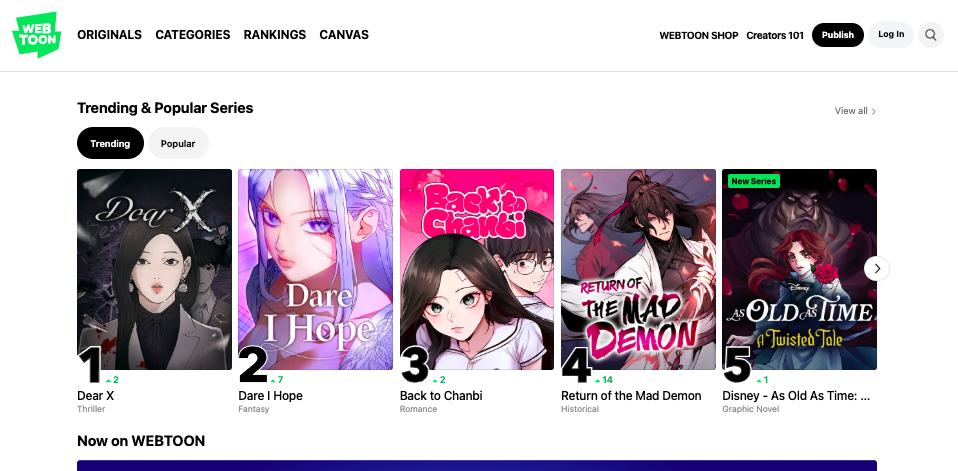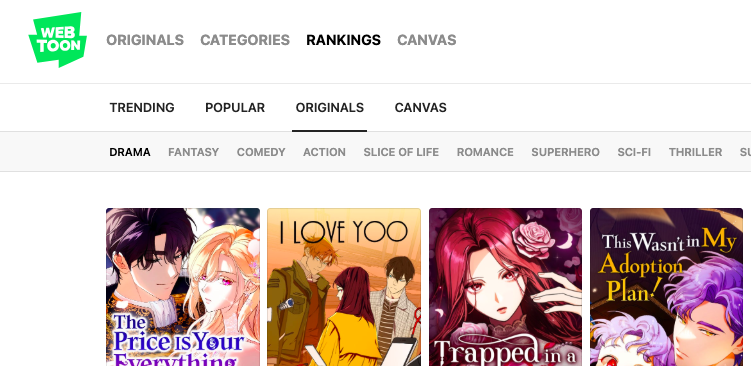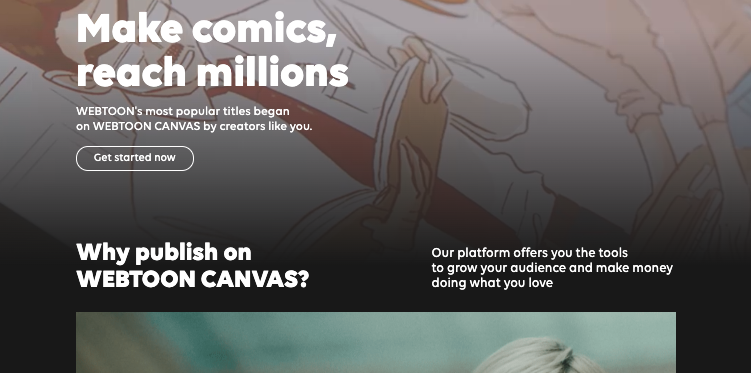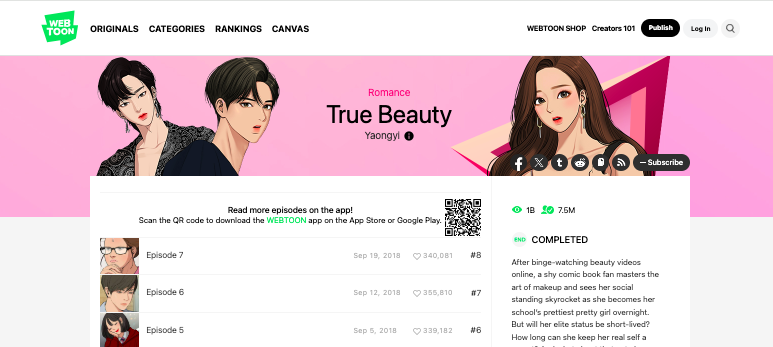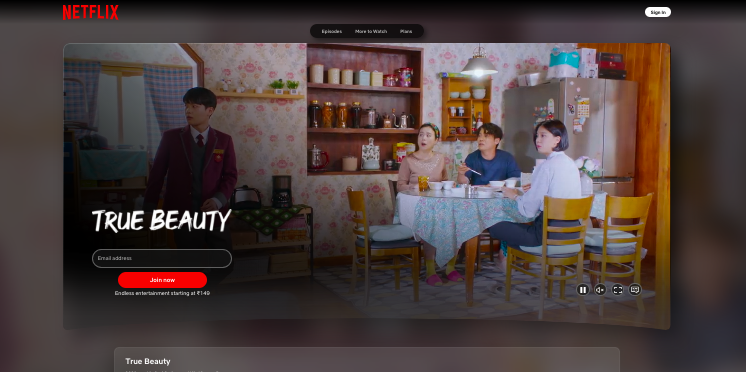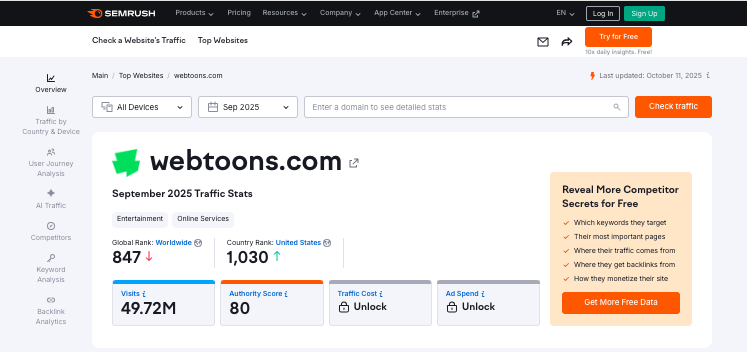Remember when reading comics meant heading to your local bookstore or comic shop, flipping through physical pages, and hoping the next issue would arrive on time?
Those days feel almost quaint now. Millions of people around the world are scrolling through stories on their phones, tapping to unlock new episodes, and binge-reading entire series in one sitting.
Webtoon, the platform that’s been quietly revolutionizing how we consume comic content. But here’s the million-dollar question: Is Webtoon really the Netflix of comics, or is that just clever marketing?
Let’s dive deep into what makes this platform tick, where it came from, and whether it deserves that streaming giant comparison.
Read on.
About Webtoon
Webtoon (stylized as WEBTOON) is a digital platform for reading webcomics that’s optimized for mobile devices.
Unlike traditional comics that spread across two-page layouts, webtoons scroll vertically, making them perfect for smartphone reading.
The platform hosts thousands of series across every genre imaginable, romance, fantasy, horror, action, comedy, slice-of-life, and plenty of wild combinations you didn’t know you needed.
Webtoon operates on a freemium model. You can read most content for free, but here’s the catch: new episodes release on a schedule, typically once a week.
If you’re impatient (and let’s be honest, who isn’t when you’re hooked on a good story?), you can purchase “coins” to unlock episodes early or access premium content. Think of it like having ads on your favorite streaming service versus paying for premium.
What sets Webtoon apart isn’t just the format, it’s the sheer accessibility. Anyone can become a creator through their Canvas platform (formerly known as Webtoon Challenge), where aspiring artists publish their work and potentially get discovered.
If a Canvas series gains enough traction, it might get promoted to Webtoon Originals, where creators receive financial support and resources.
The Korean Origins and Global Expansion
Webtoon’s story begins in South Korea, where the platform launched in 2004 under Naver Corporation. Korea’s intense internet culture and widespread smartphone adoption made it the perfect testing ground for digital comics.
The vertical scrolling format wasn’t just a gimmick, it was a solution designed specifically for how people used their phones during commutes on Seoul’s subway system.
The genius of this format became obvious quickly. Traditional comics force you to zoom in and out, swipe left and right, and basically perform gymnastics with your fingers.
Webtoons? Just scroll down like you’re checking social media. This seemingly simple innovation removed friction from the reading experience and made comics accessible to people who’d never picked up a manga or comic book in their lives.
Naver’s LINE Webtoon (the international brand) launched globally in 2014, and the expansion has been nothing short of explosive.
The platform now operates in multiple languages including English, Spanish, French, Indonesian, Thai, and more.
Today, Webtoon has over 170 million monthly active users worldwide, with the platform hosting more than 100,000 creator-owned series.
Content: Originals, Canvas, and Everything Between
Webtoon’s content structure has two main tiers, and understanding them helps explain how the platform functions as both a publisher and a creative playground.
Webtoon Originals
Originals are the professionally produced series that Webtoon directly supports. Creators receive contracts, advances, and editorial support.
These are your premium, heavily promoted series, think “True Beauty,” “Lore Olympus,” “Tower of God,” or “The Remarried Empress.”
Originals release episodes on a weekly schedule, and the production quality tends to be consistently high because creators can actually make a living from their work.
Canvas
Canvas is the community-driven side where anyone can upload their webcomics. It’s completely free to publish, and while most Canvas series remain passion projects, some breakout hits get noticed.
The dream scenario? Getting your Canvas series promoted to Originals. It’s happened enough times that creators take the possibility seriously, though the competition is fierce with thousands of new series launching regularly.
This two-tier system creates an interesting dynamic. Canvas acts as both a talent incubator and a filtering mechanism—series that resonate with audiences have a path to professionalization, while readers get access to experimental, diverse content they wouldn’t find through traditional publishing gatekeepers.
How Creators Actually Make Money?
Let’s talk cash, because the Netflix comparison only works if creators can actually earn a living, right?
For Original creators, Webtoon provides multiple revenue streams. There’s the advance payment for producing episodes, which varies based on factors like series popularity and the creator’s track record.
Then there’s ad revenue sharing—Webtoon runs ads between episodes, and creators get a cut. The platform also has a “Fast Pass” system where impatient readers pay coins to unlock episodes early, and those purchases directly benefit creators.
Canvas creators have fewer options but aren’t completely left out. The Ad Revenue Sharing program (launched a few years back) lets qualifying Canvas creators earn money from ads displayed on their series.
There’s also a tipping system where readers can directly support creators they love. Some successful Canvas creators report earning a few hundred to a few thousand dollars monthly, not life, changing for most, but a meaningful side income or supplement.
The platform has also introduced various creator grants and contests with prize pools, giving emerging artists chances to gain funding and visibility.
Still, the reality is that making full-time money from Canvas is tough. Most creators use it as a portfolio builder or passion project while working day jobs.
Webtoon Reading Experience and Community Culture
Using Webtoon feels distinctly different from reading traditional comics or manga apps. The vertical scroll creates a unique pacing rhythm, creators can control reveals and dramatic moments by strategically placing panels.
Want to surprise readers? Put a shocking image just below the fold where they’ll scroll right into it. Building tension? Stretch out a scene across many small panels that readers scroll through slowly.
The comment section culture is wild and wonderful. Readers can leave comments at specific points in an episode, not just at the end.
This creates running commentary that other readers see, turning the experience into something weirdly communal.
Popular series have comments sections that are entertaining content in their own right, filled with theories, reactions, fan art, and inside jokes.
The platform also gamifies engagement. Daily check-ins give you free coins. Watching ads earns you currency. Completing missions unlocks rewards.
It’s all designed to keep you coming back, which, yeah, that’s very Netflix-coded. The app wants to become part of your daily routine, and for many users, it succeeds.
The IP Goldmine: From Webtoon to Screen
Here’s where the Netflix comparison gets really interesting. Just like Netflix creates original content that sometimes becomes cultural phenomena, Webtoon has become a serious IP farm for the entertainment industry.
“True Beauty” became a hit Korean drama. “Sweet Home” turned into a Netflix series. “Itaewon Class” (based on the webtoon) was a massive K-drama success.
“Tower of God” got an anime adaptation. “The Sound of Magic” went to Netflix. “All of Us Are Dead” started as a webtoon before becoming a global zombie hit. The list keeps growing.
Korean entertainment companies have figured out that webtoons are essentially pre-tested IP with built-in audiences.
If a series has millions of subscribers and high engagement on Webtoon, it’s already proven there’s market demand for that story. This takes some risk out of the adaptation process, you’re not gambling on an unknown quantity.
Webtoon Entertainment (which went public last year) has been actively developing its IP across multiple formats. They’re not just licensing to other studios; they’re co-producing content and building an integrated entertainment ecosystem.
The strategy is clear: create hit webtoons, build devoted fanbases, then expand those stories across TV, film, gaming, and merchandise.
Challenges & Criticisms
No platform is perfect, and Webtoon has its share of problems that users and creators regularly point out.
The monetization structure can feel exploitative to some creators. Original contracts have been criticized for being heavily weighted in Webtoon’s favor, with the platform retaining significant IP rights even though creators do all the creative work.
Some creators report burnout from maintaining weekly release schedules while juggling other work.
The coin system frustrates readers too. Fast Pass pricing can add up quickly if you’re following multiple series, and the “three free episodes per series” limit means you might start reading something only to hit a paywall just when you’re getting hooked.
Some users feel the platform is becoming increasingly aggressive with monetization, pushing more exclusive content behind paywalls.
There’s also the content moderation question. With such massive scale and thousands of Canvas series, Webtoon struggles to consistently enforce its content policies.
Controversial series sometimes fly under the radar, while other creators complain their work gets flagged or removed seemingly arbitrarily.
Quality control on Canvas is essentially non-existent, which is both a feature and a bug. Yes, you get creative freedom and diverse voices.
But you also get abandoned series, inconsistent art, and stories that start strong then fizzle out when creators lose interest. Finding gems requires wading through a lot of rough material.
Competition & Market Position
Webtoon isn’t the only player in digital comics, though it’s definitely the biggest. Tapas offers a similar platform with its own Original and indie content.
Lezhin is huge in Korea and focuses on more mature content. Tappytoon specializes in officially translated Korean webtoons. Manga apps like Manga Plus and Viz’s Shonen Jump offer traditional manga in a similar scroll format.
What Webtoon has that competitors lack is scale and mainstream recognition. When people say “webtoon,” they often mean the platform specifically, not just the format, kind of like how “Google” became synonymous with internet search.
This brand recognition is powerful, especially as the platform pushes into mainstream entertainment through its adaptations.
The company’s market position got more complicated after going public. Now there’s pressure to show consistent growth and profitability, which means more aggressive monetization strategies.
Some long-time users worry this will change the platform’s character, pushing out smaller creators and alienating readers with increasingly expensive coin prices.
The month of Sept this year saw over 49 million Webtoon visitors. Even though the US ranking showed an upward trend, the global ranking was seen sliding.
Conclusion : Is It Really The Netflix Of Comics?
Yes, but with a twist.
Webtoon shares Netflix’s DNA, massive content libraries, binge-friendly formats, original productions, and adaptations that spawn hit shows. Both disrupted traditional industries and changed how millions consume entertainment.
But Webtoon is actually more complex. It’s Netflix meets YouTube meets traditional publisher. It’s not just distributing content; it’s nurturing creators, farming IP for adaptations, and building an entire entertainment ecosystem around vertical scrolling stories.
For readers, it’s revolutionized access to diverse storytelling. For creators, it’s opened doors while creating new dependencies. For the entertainment industry, it’s become an essential source of pre-tested stories with built-in audiences.
The Netflix comparison isn’t wrong, it’s just incomplete. Webtoon has fundamentally reshaped the comic space, and like Netflix, once you get hooked on that scroll, it’s pretty hard to stop.
Enjoyed the post?

